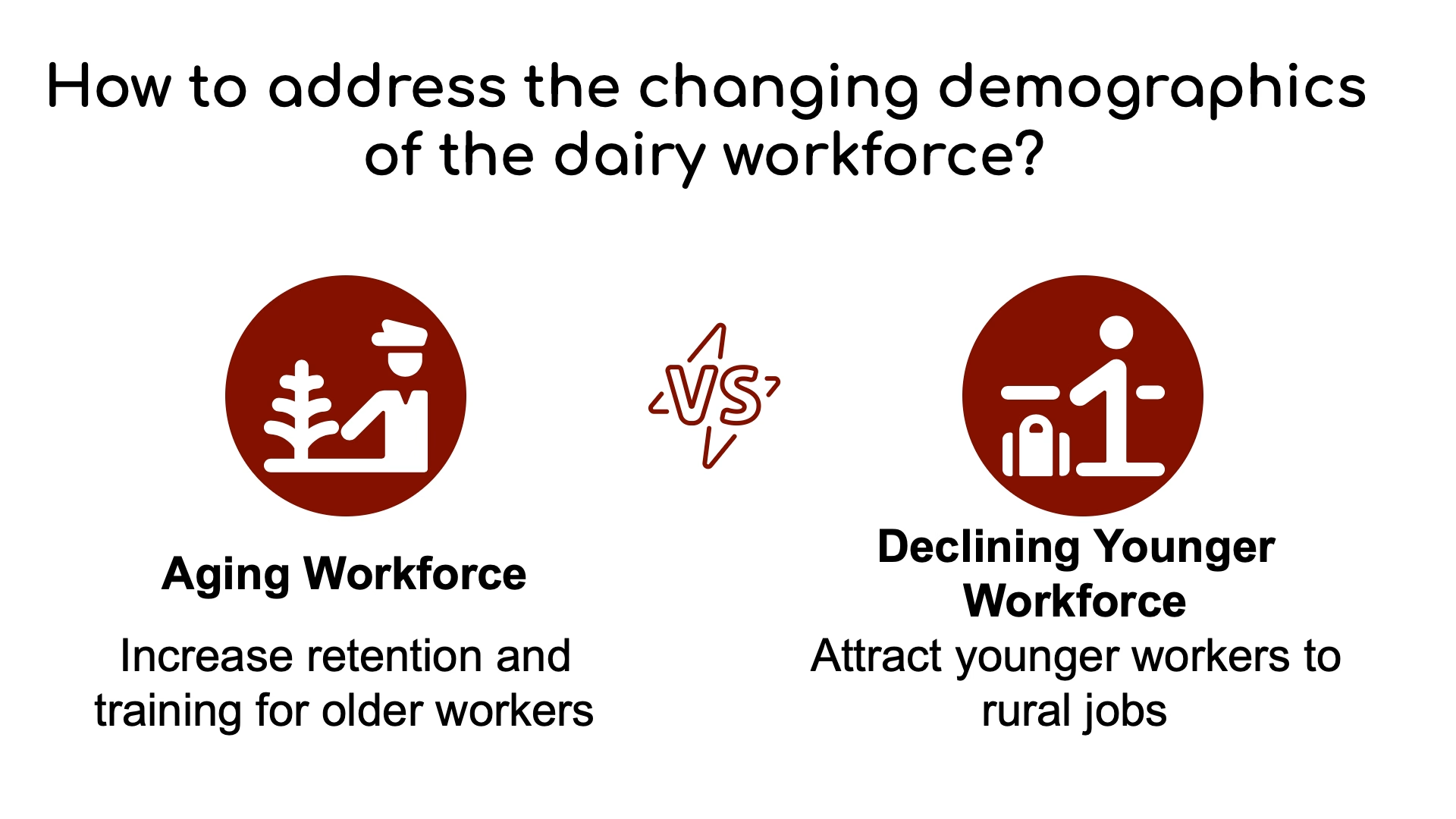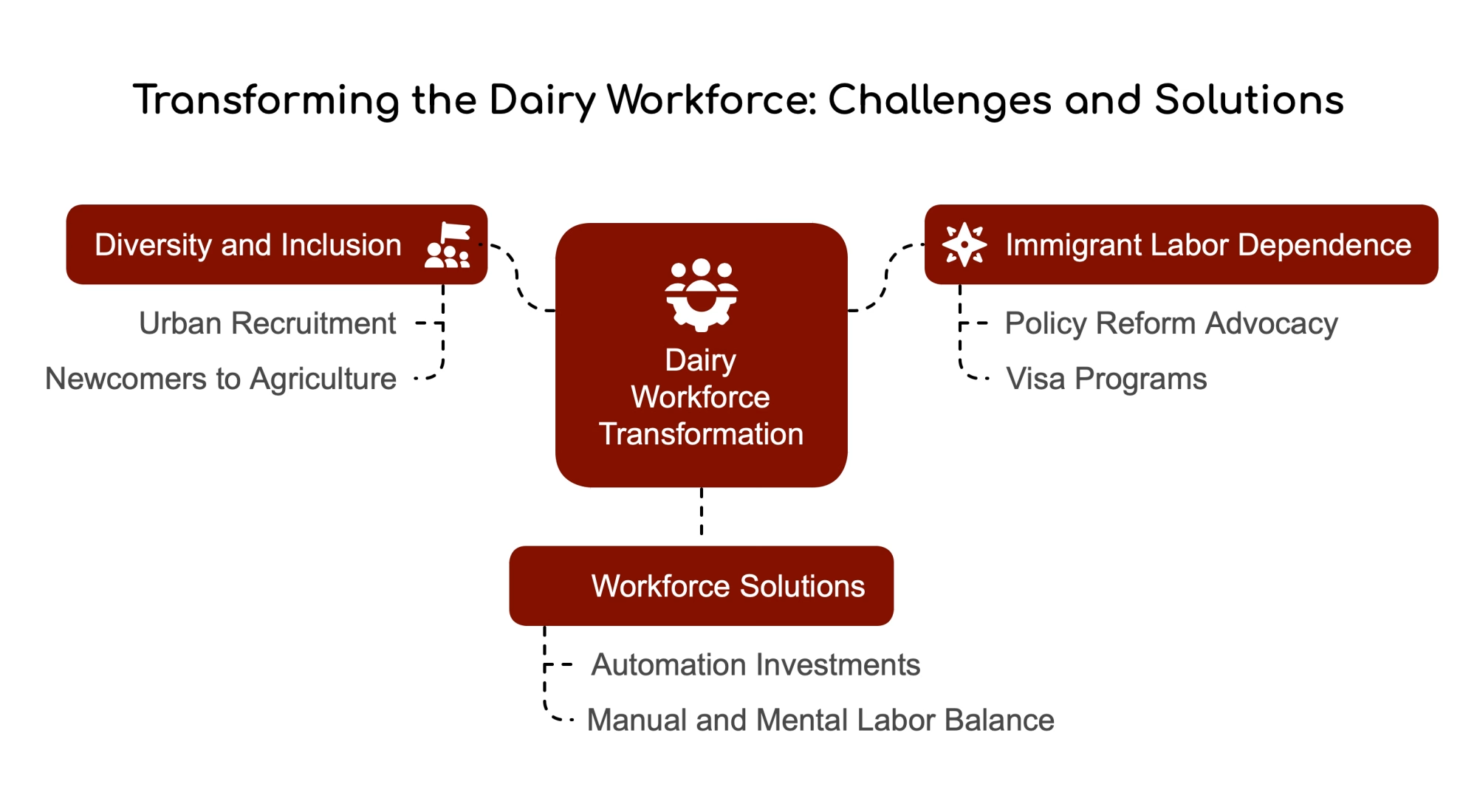Who will milk tomorrow’s herds? Dairy’s workforce crisis demands radical solutions—from robots to visa reforms—before the labor well runs dry.
EXECUTIVE SUMMARY: The dairy industry faces a looming labor catastrophe, with projections showing a 5,000-worker gap by 2030 due to aging rural populations, immigration challenges, and younger generations abandoning agricultural careers. While immigrant labor supports 79% of U.S. milk production, declining birth rates in source countries and visa limitations threaten this critical pipeline. Emerging solutions include robotic milking systems, workforce development programs with 22% higher retention rates, and competitive compensation strategies. The article urges immediate action on immigration reform and technology adoption, revealing how farms offering housing allowances (73%) and health insurance (58%) outperform peers. With labor costs projected to hit $58 billion by 2030, the industry’s survival hinges on reinventing recruitment and retention strategies.

KEY TAKEAWAYS:
- Labor Armageddon Looms: 25% of dairy workers will retire by 2030, creating a 5,000-worker deficit during peak seasons.
- Immigration Lifeline: Foreign workers produce 62% of U.S. milk, but source countries’ shrinking populations jeopardize this supply.
- Robot Revolution Rising: 41% of agribusiness leaders now prioritize automation to offset repetitive labor needs.
- Retention Pays Dividends: Farms investing in training/benefits see 22% higher worker retention within 18 months.
- Wage Wars Intensify: Dairy jobs ($27,840/year) now outearn fast food ($17,316), reshaping rural employment landscapes.

Imagine 5,000 empty milking stations—the equivalent of every dairy worker in Wisconsin vanishing. This isn’t dystopian fiction but the Canadian Agricultural Human Resource Council’s 2030 labor gap forecast. Bridging this chasm demands solutions as bold as the crisis itself.
The Alarming Workforce Cliff: Why Dairy Farms Are Losing Workers Fast
The U.S. dairy industry supports more than 3 million American jobs, generating approximately $42 billion in direct wages. Yet this critical workforce faces unprecedented pressure from multiple directions. The peak domestic labor gap in North American dairy operations is projected to increase by nearly 10% over the next several years, reaching 5,000 workers during peak season by 2030.
| Year | Total Employees | FTE Employees |
| 2008 | 188,631 | 138,124 |
| 2013 | 150,418 | 132,255 |
| 2018 | 129,453 | 116,406 |
This workforce transformation will be dramatic, with over 25% of domestic workers retiring within the next 8 years. The industry is expected to see nearly 8,000 workers retire between 2023 and 2030, replaced by approximately 1,990 immigrants and 4,770 school leavers projected to enter the workforce.
Labor Cost Reality Check
- 2023: $42 billion in U.S. dairy wages
- 2025: 15% surge in labor expenses
- 2030 Projection: Potential $58 billion (based on current trends)
Losing 3 of every 10 employees annually isn’t just disruptive—it’s financially catastrophic. With an estimated $4,000 average replacement cost per worker, this turnover drains millions yearly from U.S. dairy operations.
Why Traditional Labor Sources Are Drying Up: The Demographic Shift

The demographic landscape underlying the dairy workforce is undergoing a seismic transformation. Countries like Mexico, which have historically been significant sources of agricultural workers for U.S. dairy operations, are experiencing declining birth rates that will eventually result in smaller working-age populations.
Meanwhile, domestic demographic trends show a continuing exodus from rural areas, particularly among younger populations, increasingly choosing urban lifestyles over agricultural careers. This rural depopulation creates a perfect storm for dairy operations dependent on local labor pools.
Age demographics within the current dairy workforce further complicate the picture. According to the U.S. Bureau of Labor Statistics, workers aged 65 or older have grown by 117% within 20 years, while employment of individuals 75 years or older has also increased by 117%. The workforce is older than ever, with those under 40 making up just 45%, down from over 60% in 1984, while workers over 60 have doubled.
Immigration Pathways: How Foreign Workers Will Save Dairy Farms
| Category | Domestic Workers | Foreign Workers |
| Average per Farm | 3.2 | 2.0 |
| Milk Production Share | 38% | 62% |
| Primary Origin | N/A | Mexico (98%) |
While immigration will remain a vital labor source for dairy operations, navigating the available pathways requires increasing sophistication. Foreign workers are expected to fill over 80% of the domestic labor gap by 2030, with the total number projected to grow to over 4,000 workers. However, around 1,000 positions are expected to remain vacant even with this influx.
The dairy industry faces unique challenges with visa programs due to the year-round nature of dairy work. While the H-2A visa program allows agricultural employers to bring foreign nationals to the United States for temporary or seasonal agricultural work, its applicability to dairy operations has been limited.
“There’s a quandary of no visa program for dairymen,” says Rick Naerebout, chief executive officer of the Idaho Dairyman’s Association. While technically, a dairy producer can enroll in H-2A to find help for seasonal tasks related to crops and forage, any task related to livestock handling is off-limits. An H-2A employee engaging in these activities – even once – would violate his visa.
Will your farm be among the 30% leveraging visa programs by 2026? The industry’s future may depend on it.
The Robotic Revolution: When Technology Becomes Your Most Reliable Worker

While robots don’t file visa applications, they also don’t retire—making automation both a solution and a wake-up call for an industry at a crossroads.
Many dairy processors are turning to automation and advanced technologies to mitigate the impacts of an aging workforce. Robotics, artificial intelligence (AI), and machine learning are being integrated into processing plants to help improve efficiency, reduce reliance on manual labor, and address staffing shortages.
At Madison’s 2024 World Dairy Expo, robotic milker demonstrations drew 41% of agribusiness attendees—a clear signal of technology’s rising role in labor strategy. These technologies are particularly valuable for repetitive and physically demanding tasks on dairy farms.
10 Essential Benefits That Will Attract Tomorrow’s Dairy Workforce
| Benefit | % of Farms Offering |
| Paid Vacation Leave | 75.9% |
| Housing Allowance | 73.0% |
| Health Insurance | 58.1% |
| Retirement Plans | 5.4% |
The influx of new domestic and foreign workers will require significant training and skills development to integrate them successfully into the industry’s workforce. Farms implementing comprehensive workforce development models report 22% higher retention within 18 months—a crucial window given the 25% retirement wave approaching.
Over 60% of employers in the dairy industry found recruiting year-round Canadian workers more difficult in 2022 than in the previous year. Almost half (47%) of employers reported receiving no domestic applicants for their job postings, and 44% received only one or two applicants.
As a result of these job vacancies, 19% of employers lost sales, 30% delayed production, 47% faced overtime costs, and 35% canceled or delayed expansion plans. Forty percent of dairy employers cited lack of experience working in the sector as a top barrier for recruitment, considerably higher than the agriculture sector’s average of 31%.
Why Dairy Jobs Pay Better Than You Think: The Compensation Advantage
| Occupation | Hourly Wage | Annual Salary (54 hrs/week) |
| Dairy | $9.97 | $27,840 |
| Ranch | $11.44 | $23,754 |
| Fast Food | $8.73 | $17,316 |
While H-2A visas offer temporary relief, they’ve been called “Band-Aids on bullet wounds” by critics. With 70% of dairy farms reporting chronic vacancies, does permanent immigration reform offer the only cure?
The dairy industry reported a voluntary turnover rate of 9%, below the overall average of 14% across agriculture. This illustrates that when adequately structured, dairy operations can create more stable employment environments.
“I would like to see us develop some kind of [work] visa for a set time – at a minimum, for five years,” says Hank Hafliger of Cedar Ridge Dairy. “The dairy industry is so technical – with the knowledge required – you don’t want to train a guy and then lose him after three months.”
To attract and maintain a robust workforce, creating positive work environments with clear expectations, proper training and development, and constructive feedback on performance is essential. Supervisors play a crucial role in leading effectively by setting clear expectations, providing necessary training, and giving constructive feedback.
The Ultimate Guide to Dairy’s Workforce Future: Adapt or Decline

The future dairy workforce will be diverse, comprising immigrants and individuals from various backgrounds, including those from urban environments new to agriculture. Balancing the need for manual and mental labor remains appealing, drawing in those uninterested in traditional office roles.
A staggering 79% of the nation’s milk supply comes from farms employing immigrant labor. The stakes couldn’t be higher, with immigrant workers making up 51% of the workforce on dairy farms. Immigration reform is of particular concern to dairy farmers who rely on immigrant labor, with uncertainty surrounding policy changes adding to the industry’s anxieties.
Vote Now: Which workforce solution deserves priority?
- Expanded Visa Programs
- Automation Investments
- Urban Recruitment Drives
- Policy Reform Advocacy
The transformation of the dairy workforce represents a significant challenge and an opportunity to reimagine dairy careers for a new generation of workers. By building on the industry’s strengths while addressing its labor vulnerabilities, dairy producers can navigate this challenging workforce landscape and secure the talent needed to sustain this essential agricultural sector.
Learn more:
- The Potential $6 Billion Loss for the U.S. Dairy Industry
Explore how labor shortages, tariffs, and federal spending cuts threaten the dairy industry’s economic sustainability and workforce stability. - The Robotics Revolution: Embracing Technology to Save the Family Dairy Farm
Learn how robotic milking systems transform dairy farming by increasing efficiency, reducing labor costs, and improving cow welfare. - A Deep Dive into Challenges Dairy Farmers Face Today
This article examines the root causes of labor shortages in dairy farming and offers innovative strategies to address this issue.
 Join the Revolution!
Join the Revolution!
Join over 30,000 successful dairy professionals who rely on Bullvine Daily for their competitive edge. Delivered directly to your inbox each week, our exclusive industry insights help you make smarter decisions while saving precious hours every week. Never miss critical updates on milk production trends, breakthrough technologies, and profit-boosting strategies that top producers are already implementing. Subscribe now to transform your dairy operation’s efficiency and profitability—your future success is just one click away.







 Join the Revolution!
Join the Revolution!



